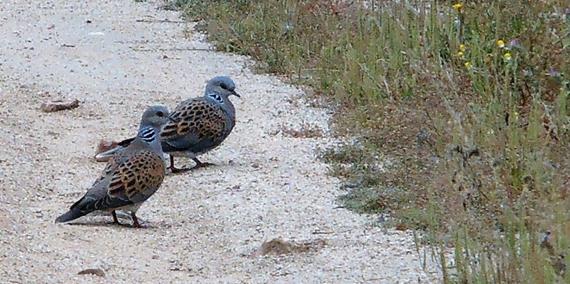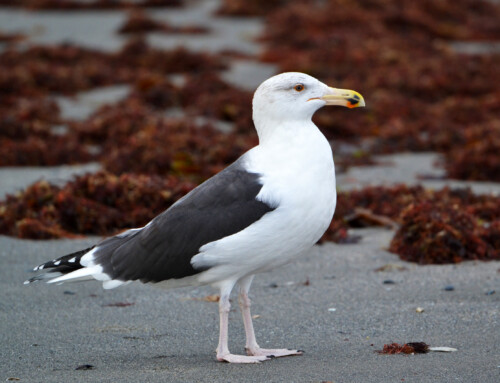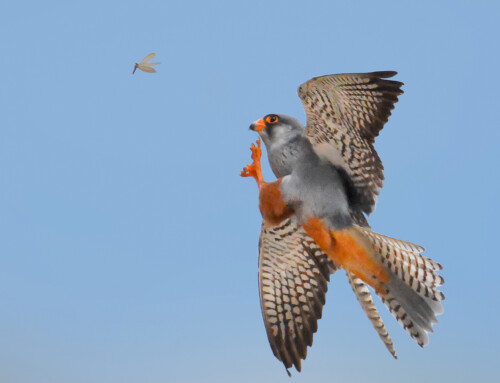What kind of wild seeds are consumed by Turtle Doves in forest areas?
LINKED PAPER
European Turtle Dove Streptopelia turtur diet composition in Southern Spain: the role of wild seeds in Mediterranean forest areas. Gutiérrez-Galán, A., & Alonso, C. 2016. Bird Study. DOI: 10.1080/00063657.2016.1236070 VIEW
The diet of Turtle Doves (Streptopelia turtur) is entirely granivorous and is mainly based on cultivated crops and seeds from plant species growing within those crops, but regarded as weeds. Wild plant seeds are an important component of the diet of Turtle Doves (Murton et al. 1964, Jiménez et al. 1992, Dias & Fontoura, 1996), and their availability is considered one of the main breeding habitat requirements for the species (Browne & Aebischer, 2003). Forest grasslands can be important foraging habitats for many granivorous species, including Turtle Doves. Hence, in cases where forest areas are distant from cultivated areas, non-crop seeds are the only available food for Turtle Doves during the breeding season in this type of habitat.
Seed availability in forest areas is not limited by the effects of modern agriculture, but depends both qualitatively and quantitatively on other factors such as grazing, tree interactions and weather (Augustine & McNaughton, 1998, Peco et al. 1998). When five years ago we started our research focused on Turtle Dove breeding habitat in Southern Spain, we realized the scarcity of data on specific feeding habits in forest areas. As we did not know which wild seed species were eaten by Turtle Doves, it was difficult to assess which factors were having a significant effect on food availability in this type of habitat.
In order to understand Turtle Dove wild seed preferences, we carried out a sampling program of Turtle Dove diet in Sierra de Andújar Natural Park, an emblematic Mediterranean forest area of Southern Spain, well known for its high abundance of wild ungulates (red and fallow deer) (Fig. 1).

We examined the contents of digestive tracts from 222 Turtle Doves shot by hunters between 2013 and 2015 in the study area. Each year, the collected Turtle Doves were hunted between 23 and 25 August, coinciding with the beginning of the legal hunting period of the species. It should be clear that most of Turtle Doves shot in Spain during the first days of hunting period, before they start their postnuptial migratory movements, come from nearby breeding areas. However, many of the Turtle Doves hunted in Spain in September can be migratory birds coming from northern areas, either from within Spain or from Central Europe. In other words, the analysed birds had been bred/grown up in the study area. Therefore, the wild seed species contained in their digestive tracts were eaten in nearby places. This is particularly important for the study of breeding habitat in forest areas, as it will enable us to assess the relation between the local abundance of wild plant species identified in diet and breeding habitat suitability in the study area.
A total of 30 species of wild seeds were found in digestive tract contents, ten of which could not be taxonomically identified (Fig. 2). Each year, just three species accounted for around 90% of the total number of wild plant seeds contained in digestive tracts (89.8%, N= 80 in 2013; 92.7%, N = 40 in 2014 and 100%, N = 13 in 2015). This showed that Turtle Doves are able to feed on a great number of wild plant seeds, but most of the volume and number of seeds corresponded to only a few species. The rest of the plant material identified in the diet consisted of different types of cultivated seeds (mainly corn, wheat, vetch, barley and sunflower).

Certain wild seed species were of special importance due to their greater volume and frequency in the diet, as well as for their known consumption by Turtle Doves in other regions and countries. The consumption of the same wild seed species in different geographical and climatic regions might indicate a preference of Turtle Doves for some wild seed species, as has been noted in other bird species (Diaz, 1990, Dimiceli et al. 2007).
Interestingly, virgin plastic granules were found in 3.8% (N = 9) of birds (4.65%, N = 5 in the first year, 2.95%, N = 2 in the second year and 4.65%, N = 2 in the third year) (Fig.3). Most plastic granules were contained in gizzards, with the exception of one bird which had them in its crop. This consumption of virgin plastic granules by Turtle Dove showed an unprecedented case of ingestion of plastic material by wild doves.

Additionally, since wild seeds were classified between those with early and late ripening, it is likely that diet composition varied throughout the breeding season according to changes in their availability (Moorcroft et al. 2006). Hence, since late seeds do not ripen until the end of June, the diet of Turtle Doves during the first half of the breeding season might only consist of early seeds. On the contrary, during the second half of the breeding season, the diet might be similar to the one described in this study, which incorporates early, late and cultivated seeds. According to this, early seeds represent the only food available in Southern Spain in May and most of June; therefore, they could have a special importance to foraging area suitability compared to late seeds (Verhulst & Nilsson 2008, Dunn & Morris 2012), especially in forest areas.
Relevance of the data obtained for further studies
Most wild plant seeds that were identified in Turtle Dove diet were nitrophilous species which are usually linked with the presence of wild ungulates and livestock (Fig. 4). In the study area, the abundance of deer and extensive livestock farming (goat, sheep and cattle) facilitates the abundance of the identified wild seeds. Conversely, in forest areas where grazers are absent, annual plant communities are commonly dominated by a few tall, competitive, large-seeded annual grasses (Noy-Meir & Briske 1996, Peco et al. 2005) which are not known to be present in Turtle Dove diet. Likewise, high-intensity grazing, as in the case of intensive livestock farming, could have a negative effect on the presence of wild plant seeds species consumed by Turtle Doves.

Therefore, grazing management appears to be an important tool for improving the Turtle Dove breeding habitat in forest areas, since it can result in substantial variation in food availability (wild plant seed species identified in the species’ diet) between forest sites that are apparently similar and relatively close to each other, but differ in terms of grazing intensity. We are currently working along this line of inquiry, which would have been impossible to pursue had this study of diet not been undertaken.
References
Augustine, D.J. & McNaughton, S.J. 1998. Ungulate effects on the functional species composition of plant communities: herbivore selectivity and plant tolerance. Journal of Wildlife Management 62: 1165 – 1183. VIEW
Browne, S.J. & Aebischer, N.J. 2003. Habitat use, foraging ecology and diet of Turtle Doves Streptopelia turtur in Britain. Ibis 145: 572 – 582. VIEW
Dias, S. & Fontoura, A.P. 1996. A dieta estival da rôla-brava (Streptopelia turtur) no sul de Portugal. Revista Forestal 9: 227 –241.
Díaz, M. 1990. Interspecific patterns of seed selection among granivorous passerines: effects of seed size, seed nutritive value and bird morphology. Ibis 132: 467 – 476. VIEW
Dimiceli, J.K., Stouffer, P.C., Johnson, E.I., Leonardi, C. & Moser, E.B. 2007. Seed preferences of wintering Henslow’ s Sparrows. Condor 109: 595 – 604. VIEW
Jimenez, R., Hodar, J.A. & Camacho, I. 1992. Summer diet of the turtle dove (Streptopelia turtur) in the south of Spain. Gibier Faune Sauvage 9: 119 – 126.
Moorcroft, D., Wilson, J.D. & Bradbury, R.B. 2006. Diet of nestling Linnets Carduelis cannabina on lowland farmland before and after agricultural intensification. Bird Study 53: 156 – 162. VIEW
Murton, R.K., Westwood, N.J. & Isaacson, A.J. 1964. The feeding habits of the Woodpigeon Columba palumbus, Stock Dove C. oenas and Turtle Dove Streptopelia turtur. Ibis 106: 174 – 188. VIEW
Noy-Meir I., Briske D.D. 1996. Fitness components of grazing-induced population reduction in a dominant annual, Triticum dicoccoides (wild wheat). Journal of Ecology 84: 439-448. VIEW
Peco B., Espigares T., Levassor C. 1998. Trends and fluctuations in species abundance and richness in Mediterranean annual pastures. Applied Vegetation Science 1: 21-28. VIEW
Peco B., de Pablos I., Traba J., Levassor, C. 2005. The effect of grazing abandonment on species composition and functional traits: the case of dehesa grasslands. Basic and Applied Ecology 6: 175-183. VIEW
Verhulst, S. & Nilsson, J.A. 2008. The timing of birds’ breeding seasons: a review of experiments that manipulated timing of breeding. Philos. Trans. R. Soc. London B: Biol. Sci. 363: 399 – 410. VIEW
Image credit
Featured image: Turtle Doves, Streptopelia turtur © Alejandro Gutiérrez Galán
If you want to write about your research in #theBOUblog, then please see here.





